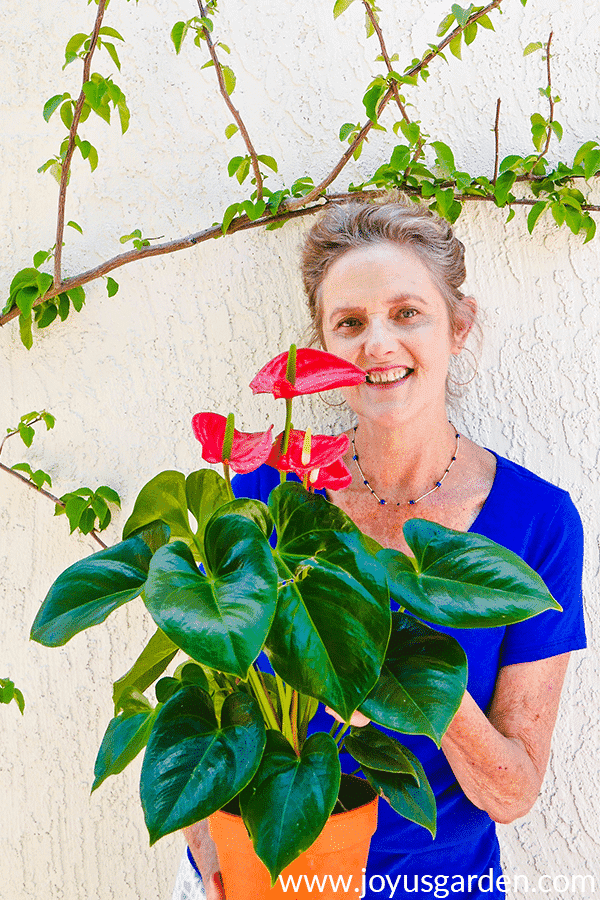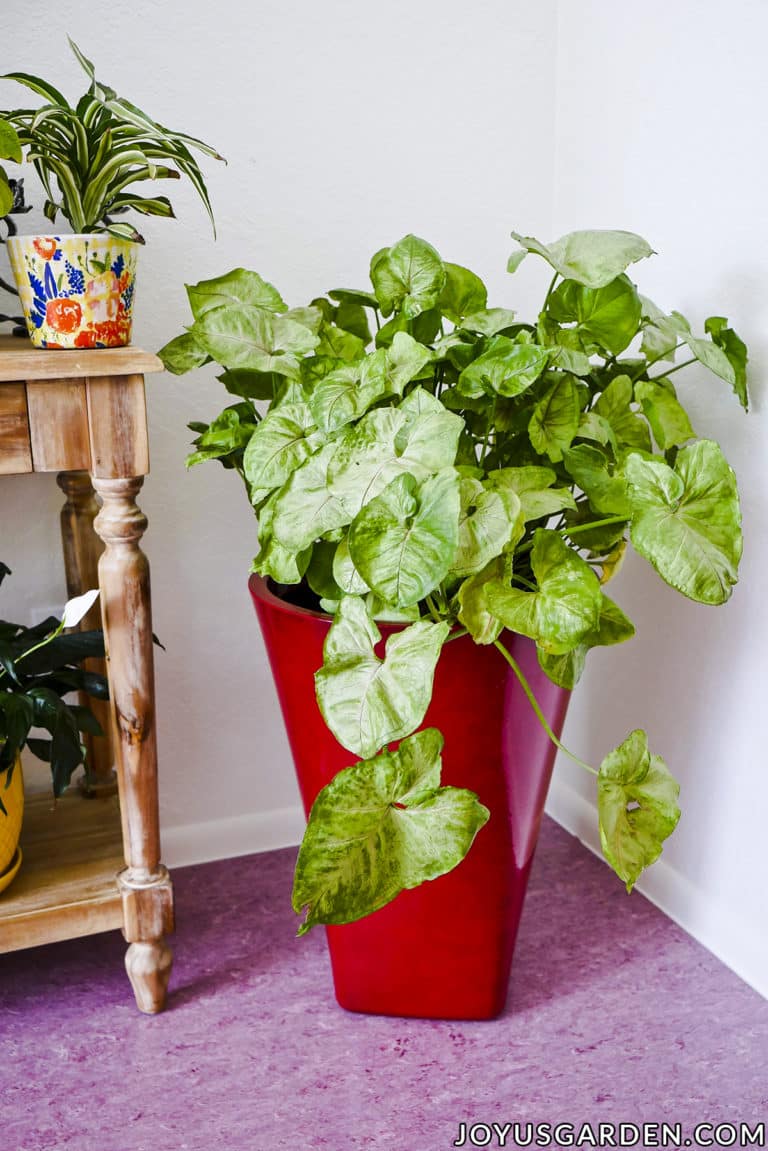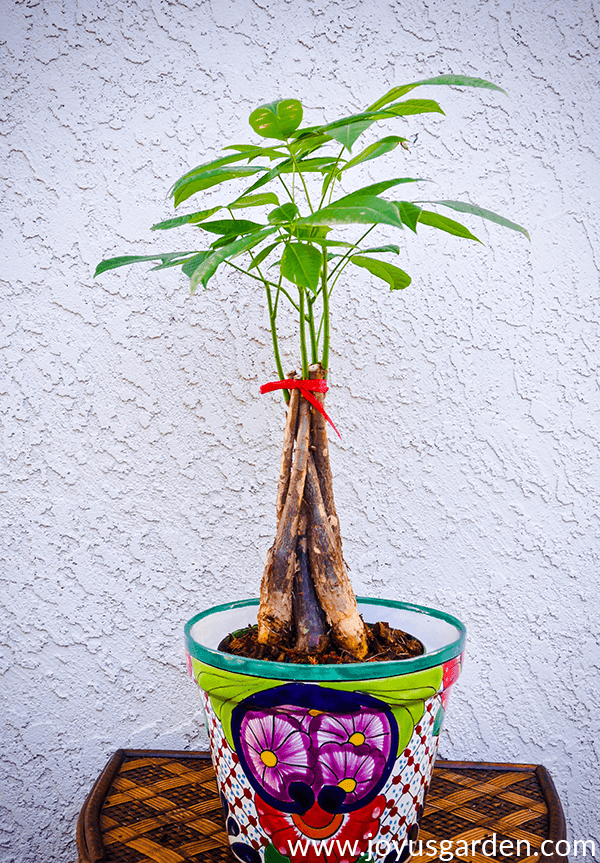Pothos N’Joy Plant Care: A Beginner’s Growing Guide
Many people are familiar with the popular Pothos plant but might not know that it comes in multiple varieties. The Pothos N’Joy has lovely green and cream variegated heart-shaped leaves that set it apart from a solid green Pothos or the popular Golden Pothos. Pothos N’Joy plant care is similar to most other Pothos varieties, except for its exposure needs; more on that below.
Pothos plants don’t require much fuss. Over the years, I’ve collected a few, and they’ve all done well in the multiple homes in multiple climate zones I’ve grown them in. These plants are low maintenance and can survive with minimal care, making them an ideal choice for those new to growing houseplants.
I outline what you need to know about Pothos N’Joy plant care, including light requirements, watering, propagation methods, soil preference, and much more. So, let’s dive in and discover the ease of caring for a Pothos N’Joy!
- Botanic name: Epipremnum aureum N’Joy
- Common name: Pothos, Devil’s Ivy — You may also see this labeled as Pothos N Joy, Pothos njoy, N Joy Pothos, Pothos NJOY
This post may contain affiliate links, you can read our policies here.
Pothos N’Joy Plant Traits
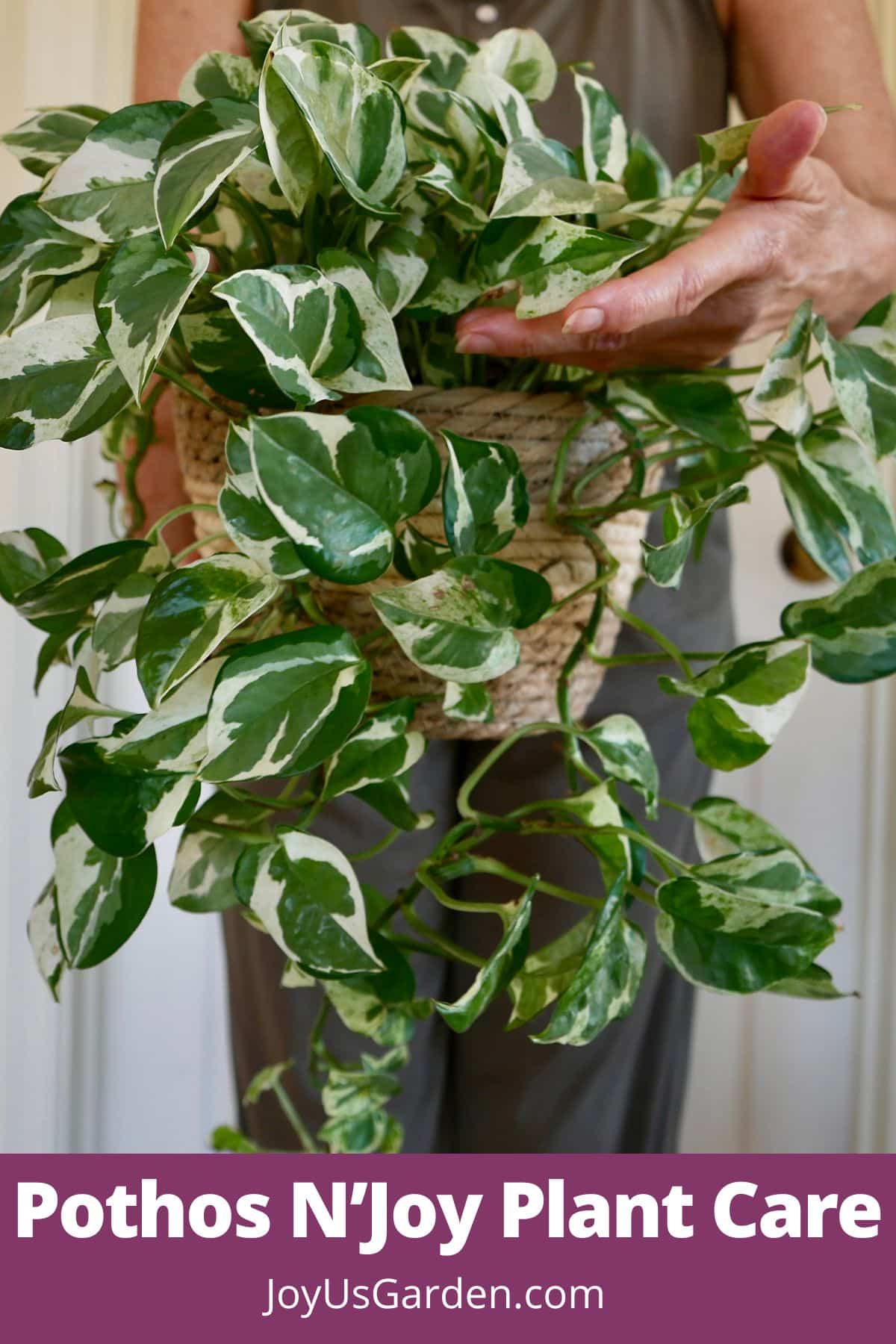
How to Use Pothos NJoy
Pothos N Joy are trailing plants and are great to use in a hanging container. I have my Pothos N Joy in a basket that sits atop my long plant table with other houseplants. The bright foliage trailing vines make it stand out from the other upright plants on the table.
This plant loves to have its trails dangling, so don’t be afraid to hang your Pothos if you’d like it to trail down gracefully.
This hanging shelf, this hanging shelf, and this hanging basket are great options for displaying your pothos. I have all three of them!
I’ve also seen them growing upright over hoops, on a tall piece of wood or bark, on trellises, on a moss pole, and attached to walls and in dish gardens and living walls.
Size
You can buy them in 4, 6, 8, and 10″ grow pots. The 6 – 10″ pots often have hangers attached. They’re easy to snap off if you wish to remove them.
My N’Joy, growing in a 6″ pot, is 18″ wide x 33″ long. Because it’s on a table, I prune it once or twice a year to keep it from hitting the floor.
They typically max out at 8-10 feet long when growing indoors.
Growth Rate
Most pothos have a moderate to fast growth rate, particularly in warmer temperatures. During the winter, the growth of most houseplants tends to slow down, so it’s normal not to observe significant growth in the cooler months.
Pothos growing in low light conditions also experience a slower growth rate. If you have the space to allow it to thrive in higher light, seize the opportunity for faster growth, more fullness, and better variegation.
The Pothos N’Joy is slower growing than the Golden Pothos or Neon Pothos.
Pothos Varieties
Numerous types of Pothos cultivars and varieties are available, including Golden Pothos, Marble Queen Pothos, Jade Pothos, Neon Pothos, Pothos Pearls and Jade, Glacier Pothos, Pothos Snow Queen, Jessenia Pothos, Blue Pothos, and Silver or Satin Pothos. It’s worth noting that Silver or Satin Pothos, although belonging to a different genus, is often grouped with pothos under its common name.
These pothos plants are cultivated by growers across various regions, primarily in Florida, California, Texas, and Hawaii.
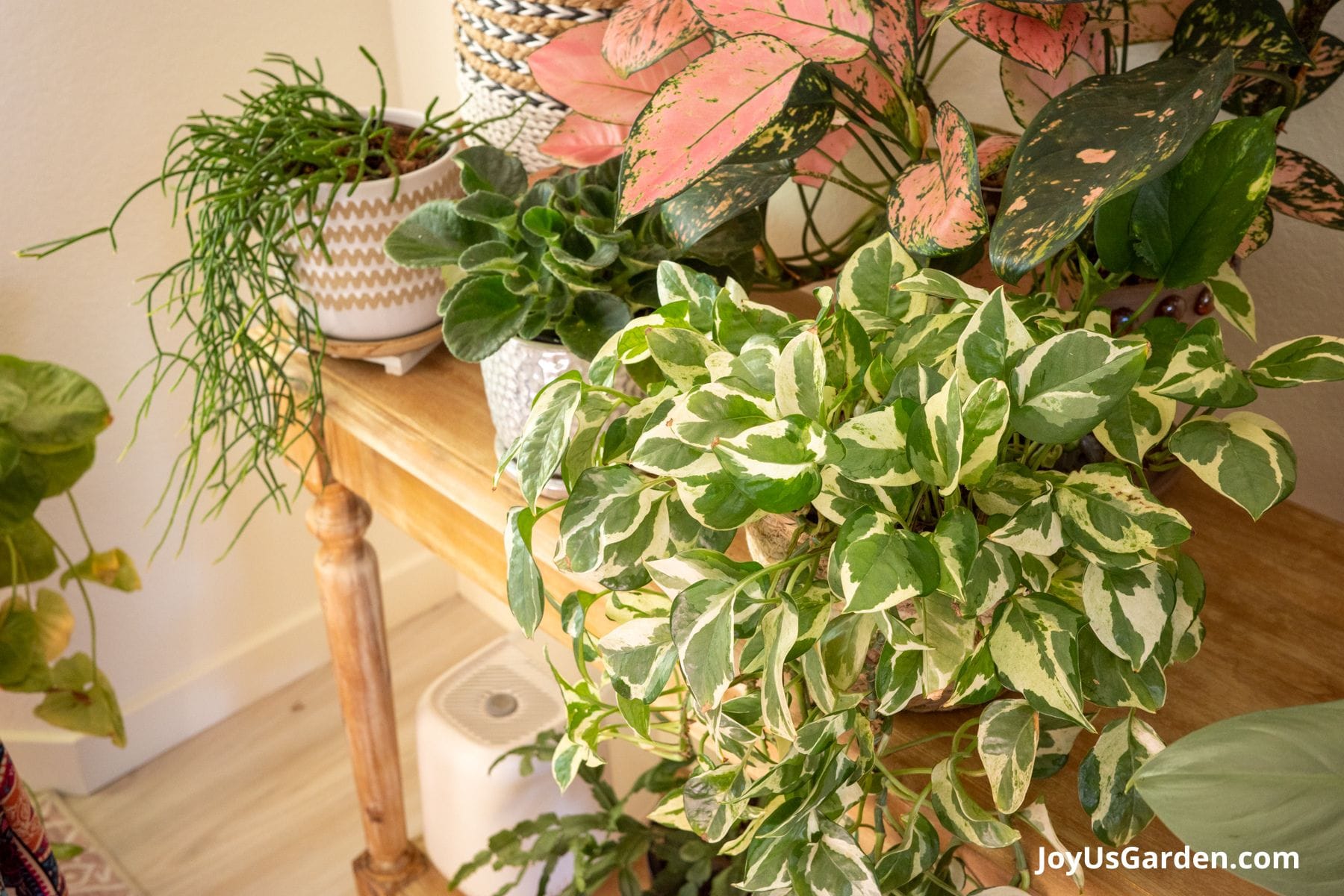
Pothos N’Joy Plant Care And Growing Guide
Light Requirements
Pothos NJoy has variegated leaves, so it will need brighter light than a solid green Pothos to keep the foliage vibrant. Typically, optimal growth for a Pothos N Joy occurs in medium to high bright light. The ideal condition is moderate light or bright indirect light.
While high light is acceptable for a Pothos N’Joy, it’s essential to maintain a distance of at least 6-10 feet from a west or south-facing window to prevent potential burning in direct, intense sunlight.
These plants grow even slower in low-light settings, leading to a leggy, sparse appearance and smaller leaves. A Pothos NJoy (and other variegated types) will lose variegation in such conditions.
To ensure even exposure to light, rotate the plant occasionally if you observe the leaves leaning toward the light source. If the light diminishes significantly during winter, consider relocating the plant to a spot with more light. More on winter houseplant care here.
I’ve done a post & video answering your FAQs About Pothos Plants that you’ll find helpful.
Pothos N’Joy Watering
I thoroughly water my NJoy Pothos plants when the soil goes almost dry.
Here in the desert (I live in warm, sunny Tucson, AZ), that’s once every 6-7 days in the warmer months. It’s less often in the winter, maybe every 9-14 days.
Providing an exact watering schedule is challenging as the watering needs of Pothos depend on factors like the location it’s growing in, your home’s environment, the soil mix used, and the size of the pot.
Keeping the soil somewhat dry rather than consistently wet is best to prevent root rot. Make sure the pot has drainage holes at the bottom, allowing excess water to drain freely. Care should be taken to prevent too much water from building up in the saucer if one is placed beneath the pot.
A Pothos requires less water and a break from fertilizing and pruning during winter. Adjusting your care routine to these seasonal changes contributes to the plant’s overall health.
I’ve done a guide to watering indoor plants that you may find helpful.
Temperature
Maintaining the right temperature for Pothos care isn’t complicated. They have a broad temperature tolerance, and if your home is comfortable for you, it’ll likely be comfortable for your Pothos and other houseplants.
It’s best to avoid placing them near cold drafts or in proximity to heating or air conditioning vents.
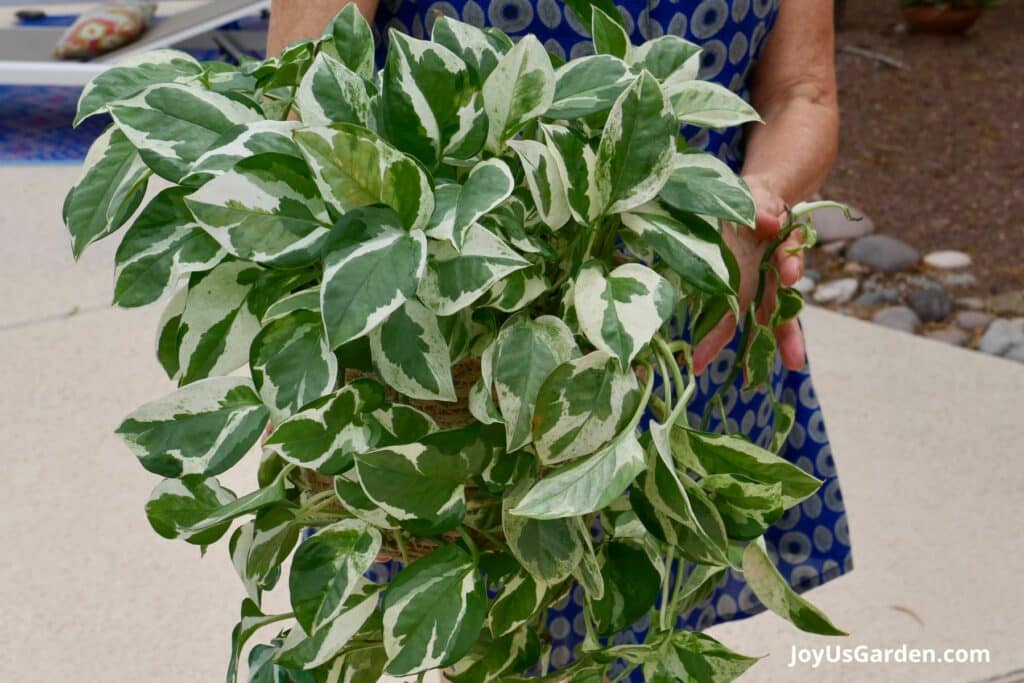
Humidity
Pothos, tropical plants accustomed to high humidity, surprisingly thrive in the lower humidity levels typical of our homes.
If you notice occasional brown tips on the leaves, it’s likely a response to the dry air. Mine has some tiny brown tips, but you have to get close to see them.
For those looking to increase humidity in their homes, here’s a suggestion:
I have this humidity meter in my dining room. It’s inexpensive but gets the job done and still works fine after a few years. I run my humidifiers at night when the humidity reads low, often in the Arizona desert!
Misting a couple of times a week will help. This is the mister I’ve used for a few years, and it’s still going strong.
Pothos Fertilizing
The optimal time for fertilizing your plants is during spring and summer. If you reside in a temperate climate, you can extend fertilization into early fall.
We have a long growing season here in Tucson from mid-February through October. I fertilize with Maxsea or Sea Grow, Grow Big, and Liquid Kelp seven times (once per month) during the growing season. It’s how I feed all my tropical plants. I alternate using these granular and liquid fertilizers individually and don’t mix them.
Depending on your climate and growing zone, providing nutrients two or three times a year might suffice for your indoor plants.
Pothos N Joy doesn’t require too much attention regarding fertilizing. It’s crucial to avoid over-fertilizing, as this can be more detrimental than beneficial.
Regardless of the houseplant food you choose, it’s essential not to exceed the recommended amount or frequency, as the accumulation of salts can lead to root burns. Signs of overfertilization often look like brown spots or large brown tips on the leaves.
Refraining from fertilizing is best in late fall and winter as it’s not the active growing season for houseplants. Additionally, it’s best to avoid fertilizing stressed houseplants, whether bone dry or excessively wet. This practice helps ensure the well-being of the plants during periods of reduced activity or stress.
Soil
For my Pothos NJoy, I always use good quality potting soil formulated for houseplants, which is peat-based, well-nourished, aerated, and has good drainage.
These are the potting soils I alternate between using: Ocean Forest and Happy Frog. I also add a few amendments to the potting mix when planting. You can read more about my soil blend by clicking the link in the “Repotting” section below.
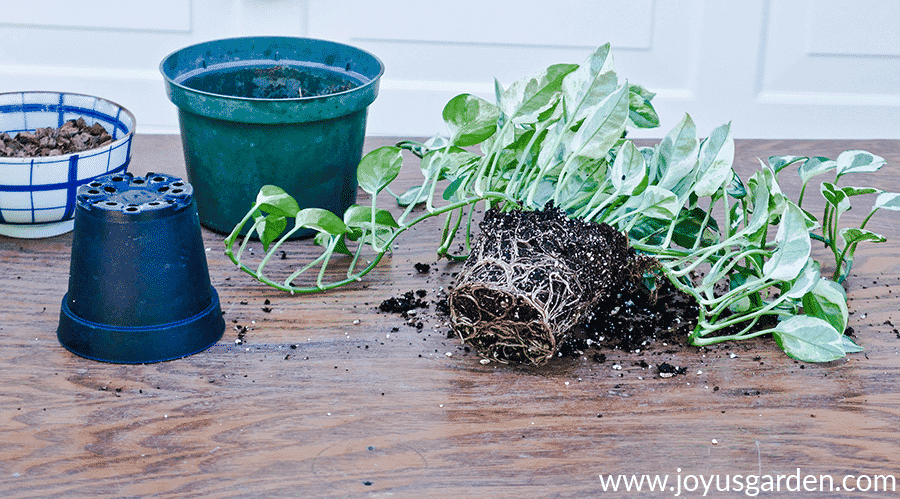
Repotting/Transplanting
Spring and summer are the prime seasons for repotting your Pothos, while early fall is fine for those in warmer climates.
When repotting, I typically transition to a larger pot size, such as moving from a 4″ to a 6″ pot. If your 6″ Pothos is large and tightly packed in its current pot, you might consider repotting it into a 10″ pot. You want the pot size to be in scale with the size of the plant.
A clear sign it’s time to repot is when roots emerge from the bottom of the pot. Generally, I repot Pothos every five years to provide the roots with more space to grow and to replenish the soil.
If your N Joy has longer trails, there’s potential for tangled growth. I loosely tie the trails together to keep them manageable and out of the way during repotting. My Golden Pothos has really long trails. I gently put them in a pillowcase to keep them out of the way during the repotting process!
As for the type of pot, the material doesn’t significantly impact the plant’s well-being. I’ve successfully grown Pothos in plastic, terra cotta, fiberglass, resin, and ceramic pots—all serving the plant well.
It’s best if your pot has at least one drainage hole on the bottom so the excess water doesn’t build up, preventing root rot.
This post on Pothos Repotting details how to repot pothos and the soil mix to use.
Pothos Pruning
Pruning is necessary for N’Joy Pothos plant care.
You can prune your pothos to manage the length by making a straight cut across the stem just below a node. This will also encourage new growth at the top.
Similar effects can be achieved by pinching or tip pruning the trails (1-2 nodes back). I’ve done both methods on my Pothos NJoy to promote and maintain its fullness. And to keep it from hitting the floor!
You can trim off and propagate trails with leafless sections, as leaves won’t grow back on those bare parts of the stems.
Just like fertilizing and repotting, it’s ideal to do pruning during the spring and summer months.
Propagating
Pothos N Joy propagation is incredibly straightforward and fast, especially by stem cuttings in water, a method I consistently find success with. Aerial roots naturally develop from the nodes along the stems, so propagation is a breeze.
To initiate the process once you have taken the cuttings, strip off an adequate number of leaves from the stems (typically 1-4, depending on the length of your cuttings) and submerge them in water. Fill your glass or jar with enough water to cover one to two nodes. Keep any foliage above the water level.
Maintain the water at this level, refilling as needed. You’ll start to see roots emerge typically within seven to ten days.
I’ve kept Pothos stem cuttings in water for eight months, and they’ve remained healthy.
This post and video on Pothos Propagation will give you more details on propagating and pruning.
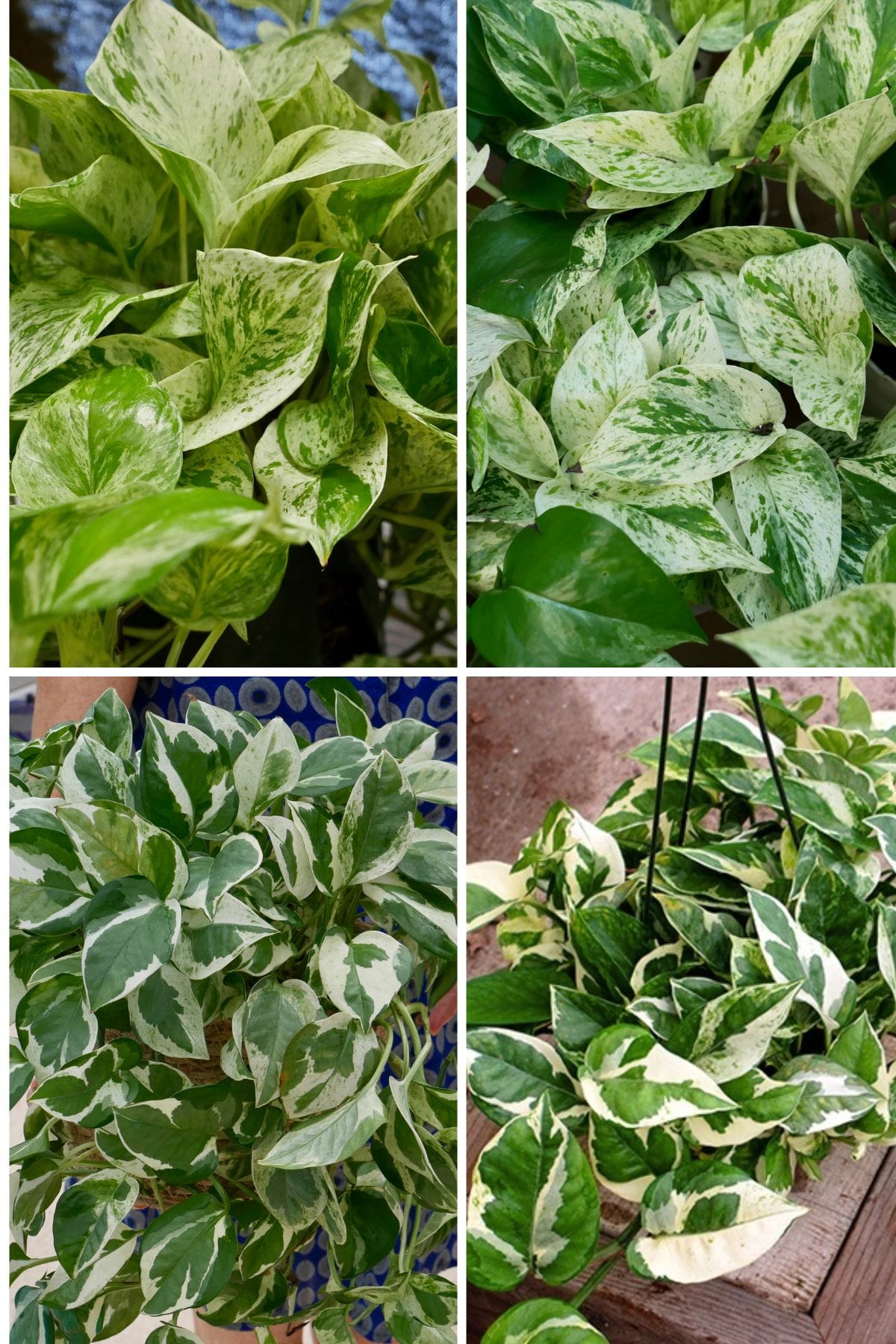
Pests
When I lived in Santa Barbara, my pothos got mealybugs. I spotted them early on and took action.
While working as an interior landscaper, I saw pothos infested with spider mites and scale.
Pests tend to spread from one houseplant to another, so it’s important to act swiftly once you see plant pests.
For most pest infestations, you can control them with neem oil or insecticidal soap. The latter is what I’ve been using for two years now and has been effective.
Yellow Leaves On Pothos Plants
The occasional appearance of a yellow leaf is a normal part of a plant’s growth cycle, and I routinely remove one or two yellow leaves from my Pothos every few months.
Nevertheless, an abundance of yellow leaves signals something is wrong. Various factors, such as overwatering, underwatering, excessive fertilizer, inadequate or excessive light exposure, pest infestation, and poor soil drainage, could contribute to this issue, with overwatering being a particularly common culprit.
To maintain the plant’s appeal, you can remove any yellow leaves.
Toxic To Cats & Dogs
Pothos are considered to be toxic to pets. I consult the ASPCA website for my info on this subject and see in what way the plant is toxic.
If your pets tend to chew on plants, I suggest elevating your pothos or hanging them out of reach. This makes it challenging for them to access and helps prevent potential harm.
Here’s a list of 11 pet-friendly houseplants for your reference.
This general post on Pothos Plant Care will help begin gardeners.
Pothos N’Joy Plant Care FAQs
Yes, Pothos NJoy is an easy-to-care-for and low-maintenance plant. It’s a great starter plant for beginners. They thrive in bright, indirect light and are happy growers with the right care.
They are moderate growers if the conditions are to their liking. Growth rates can slow down in lower light conditions and cooler temperatures. Golden Pothos and Neon Pothos are fast growing.
Provide bright, indirect light for the healthiest growth. While Pothos n joy can tolerate lower light conditions, they will lose variegation and/or become sparse and rangy.
Pothos are climbing plants in their natural environments. They use their aerial roots to climb up other plants. You can train them to climb up trellises’, moss poles, and pieces of wood. I’ve only seen them sold as hanging plants.
The watering needs of Pothos depend on factors like your home’s environment, the soil mix used, and the size of the pot. Overwatering is a common issue with Pothos, so allowing the soil to almost dry out between waterings is crucial to prevent root rot.
In conclusion, Pothos N’Joy care is incredibly easy, and their long and abundant trails make them especially appealing. These houseplants are low-maintenance and adaptable, thriving whether grown as climbers or trailers. And that jazzy, vibrant foliage brightens up any room!
Happy Gardening,


